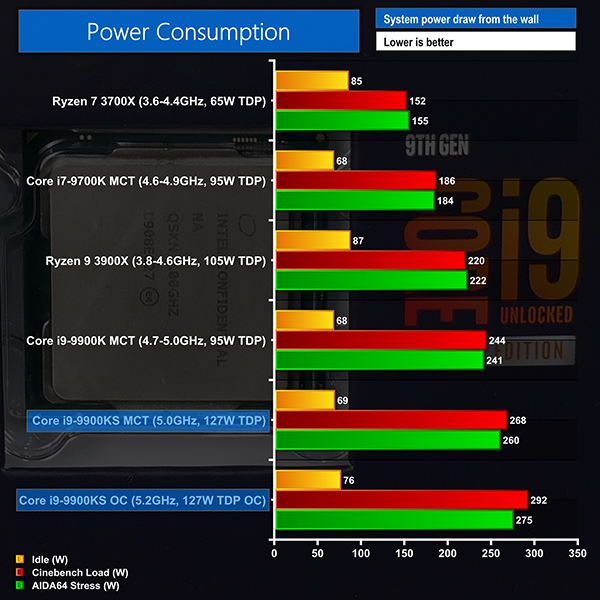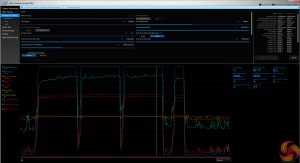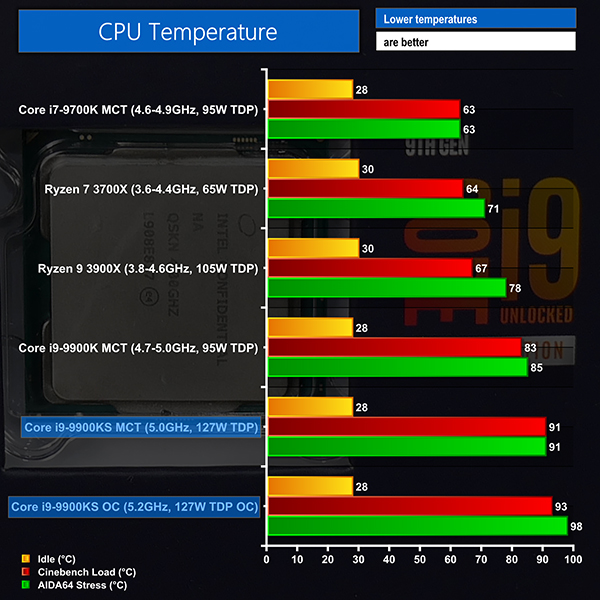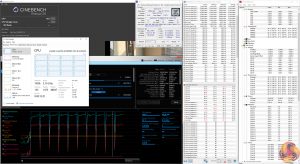We leave the system to idle on the Windows 10 desktop for 10 minutes before taking a power draw reading. For CPU load results, we read the power draw while producing approximately 5 minutes worth of runs of the Cinebench R20 multi-threaded test. We also run 10 minutes of AIDA64 stress test.
Both Cinebench and AIDA64 are used as some CPUs – most notably Intel's HEDT Core processors when operating under default turbo conditions – will heavily reduce their clock speed with the AIDA64 workload, thus giving an unrepresentative reading.
The power consumption of our entire test system (at the wall) is shown in the chart. The same test parameters were used for temperature readings.
Power Consumption
Power draw readings are accurate to around +/-5W under heavy load due to instantaneous fluctuations in the value. We use a Titanium-rated Seasonic 1000W Prime PSU (with 8-pin plus 4-pin or 8-pin plus 8-pin power connectors where possible).
Power consumption is the clear caveat when it comes to owning Intel’s 5GHz eight-core i9-9900KS processor. Despite Intel’s claims of higher-grade silicon for the 9900KS versus the 9900K, the voltage has still been pushed hard in order to maintain the 5GHz clock speed.
This results in the 9900KS showing the highest power consumption figures for all of today’s comparisons. The increase versus the stock – 4.7GHz – Core i9-9900K is 24 Watts in Cinebench.
Our software readings highlight a peak CPU package power of just under 210W, which is around 30-40W higher than the 9900K’s software readings. AMD’s Ryzen 9 3900X looks highly efficient by comparison, despite featuring 50% more cores and threads and higher multi-threaded performance in general.
Remember the Ryzen 7 3700X being just a few percentage points behind the Core i9-9900KS in many productivity tests such as Cinebench and Blender? That Zen 2 chip uses more than 100W less power to achieve performance that isn’t too far behind the 9900KS. It is clear that Intel has pushed the silicon incredibly hard to achieve such high frequencies.
Unsurprisingly, the performance per Watt from Intel’s Core i9-9900KS is poor, just as we see from the other high-frequency Coffee Lake Refresh parts in productivity applications such as Cinebench and Blender. The difference in efficiency between 7nm Zen 2 and highly clocked Coffee Lake Refresh 14nm++ chips is gaping.
Temperatures
Temperature recordings were taken using a 240mm Corsair H100X all-in-one liquid cooler with two SP120L fans running at 2435 RPM. Ambient temperatures were around 24°C.
Given the high power draw, it is absolutely no surprise to see high operating temperatures from the Core i9-9900KS. We were forced to upgrade our 240mm Corsair H100X AIO from 1700 RPM fans to 2435 RPM Corsair SP120L alternatives in order to keep stock 9900KS temperatures in check.
If you’re buying this processor, make sure you invest in a high-end CPU cooler. There may be additional headroom to reduce the voltage whilst maintaining the 5GHz clock speed, so that’s probably worth trying. If you want to overclock past 5.0GHz, be prepared to bash against the 100°C Tjmax in certain workloads.
Our logs showed 220W software-reported CPU package power when running at 1.38-1.392V CPU VCore. That’s a lot of thermal energy for a CPU cooler to move away from a mainstream-sized CPU heatspreader.
Be sure to check out our sponsors store EKWB here
 KitGuru KitGuru.net – Tech News | Hardware News | Hardware Reviews | IOS | Mobile | Gaming | Graphics Cards
KitGuru KitGuru.net – Tech News | Hardware News | Hardware Reviews | IOS | Mobile | Gaming | Graphics Cards







